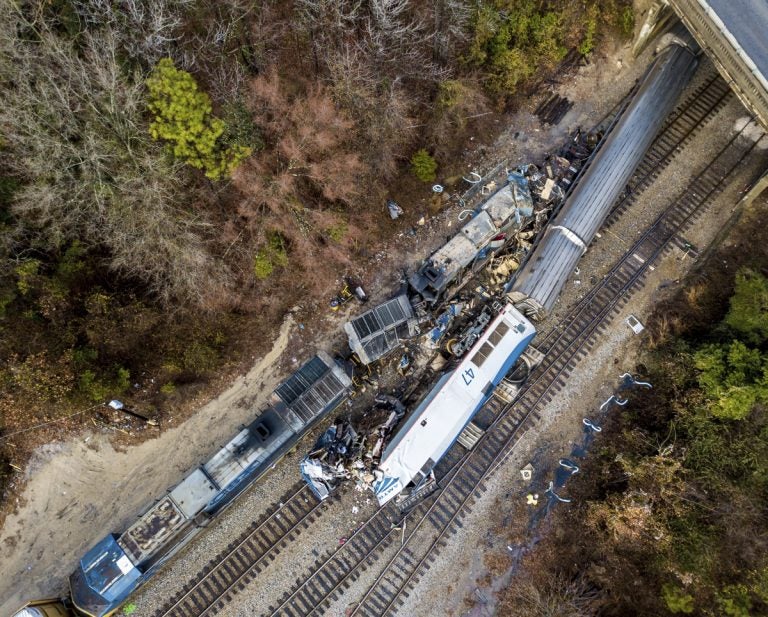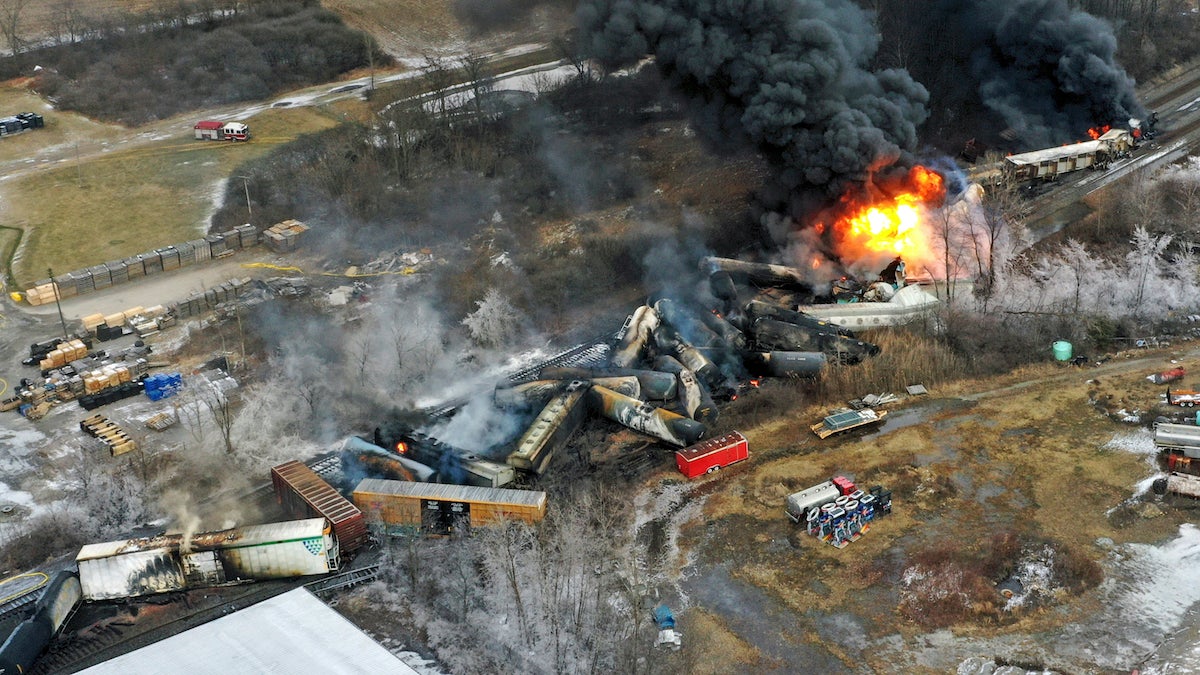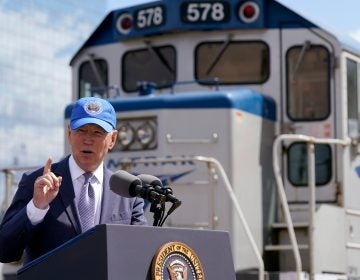Philly area lawmakers oppose Trump plan to cut Amtrak funding
The budget plan proposes cutting in half the federal subsidy for Amtrak, including slicing grants to the Northeast Corridor by $128 million.
Listen 5:00
An aerial view of the site of an early morning train crash Sunday, Feb. 4, 2018 between an Amtrak train, bottom right, and a CSX freight train, top left, in Cayce, SC. The Amtrak passenger train slammed into a freight train in the early morning darkness Sunday, killing at least two Amtrak crew members and injuring more than 110 people, authorities said. (Jeff Blake/AP Photo)
After a series of high-profile train crashes across the nation, lawmakers from the Philadelphia region are wondering why President Donald Trump’s budget calls for slashing Amtrak funding.
The budget plan proposes cutting in half the federal subsidy for Amtrak, including slicing grants to the Northeast Corridor by $128 million.
The proposal follows three deadly crashes this year. And with more than 800,000 passengers riding rail daily from Washington, D.C. to Boston, Republican U.S. Rep. Leonard Lance said this is the time to invest in the nation’s aging rail system.
“It’s important to the entire region — regardless of political party — and it’s an alternative to driving in automobiles, and it is environmentally sound,” said Lance, who represents Central Jersey.
The president’s new infrastructure plan proposes designating $200 billion in federal funds to attract $1.3 trillion in state, local, and private funding.
Lance said he’s pushing his party’s leaders to offer more.
“I would prefer to see more money from the feds,” he said. “There will have to be a partnership, but I would like to see more money from the federal government.”
The three recent deadly crashes already had lawmakers talking about increased rail spending. The 2015 crash in Philadelphia that killed eight and injured hundreds still hangs in the minds of many area lawmakers. And last month, a judge reinstated criminal charges including manslaughter against the Amtrak engineer.
As the investigations into the recent crashes continue, U.S. Sen. Bob Menendez of New Jersey said Congress is looking for ways to stem this deadly tide.
“We need intercity rail service that is safe as well as efficient,” the Democrat said. “And when somebody gets on a train … they should be able to feel that they are going to come home safe and sound to their family.”
In 2008, Congress mandated that trains implement a safety system called positive train control or PTC by the end of 2015. After it became clear that many railroads would miss the deadline, Congress moved the deadline to 2018.
So far, Amtrak has PTC on about 69 percent of its tracks — including the entire line from Boston to Washington. Menendez, who is planning to introduce legislation compelling train companies to implement PTC, said Congress must stop postponing the deadline.
“It’s past due,” he said. “We need to stop extending the period and make entities respond. We’re not going to take the responsibility over from agencies, but we are going to try to be a partner in it because we’re talking about the safety of our people.”
Besides new infrastructure, maintenance needed
Now that Trump has called for a new infrastructure package, lawmakers said it’s an opportunity to address long-overdue maintenance on existing lines.
“There’s over $20 billion in rehab projects just along the Northeast Corridor,” said U.S. Rep. Ryan Costello, a Republican. “So, I mean, we start talking about passenger rail and new funding … the first thing we need to do is deal with existing rehabilitation projects before you lay a new line of track anywhere.
“The problem’s only going to become more acute and more expensive in time.”
Costello, who represents parts of four counties west of Philadelphia, said Northeastern Republicans’ best chance of getting more rail funding is agreeing to some investments that are important to their colleagues in the South and West.
“Rural America will have to get their piece of the pie, too, and that’s everything,” he said.
Costello predicted a solid bloc of Republican lawmakers will oppose Trump’s proposed Amtrak cuts.
“You could see a lot of suburban or ex-urban Republicans — who feel passenger rail is critical to the regional economy — lean in heavy with that being something that’s extremely important,” he said. “It is to me.”
The president’s plan to put forward just $200 billion for more than $1 trillion in transportation projects — including rail — has triggered considerable frustration on both sides of the aisle.
U.S. Sen. Tom Carper, who takes the train to Washington every day from Delaware, was invited to the White House recently to discuss the transportation package. He said he had some questions for Trump.
“How do you want to pay for this? Do you really think that $200 billion will somehow leverage another $1.5 trillion? Do you think that’s fair to state and local governments?” recalled Carper, a Democrat.
The president is asking state and local governments in the region to pony up more money for transportation projects.
Now, lawmakers from Delaware, New Jersey, and Pennsylvania are wondering whether that is an opening bid or his final offer.
WHYY is your source for fact-based, in-depth journalism and information. As a nonprofit organization, we rely on financial support from readers like you. Please give today.



